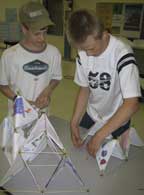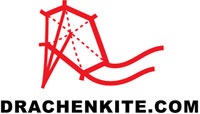
Level: Intermediate (3-5/6)
Grade From: 4
Grade To: 8
Length: 3-6 sessions, including student readings, kite making, and kite flying. Sessions can be taught in a different order, with some combined or omitted. The kite alone can be constructed in about 40 minutes (no decoration and no flying time).
Focus:
These readings and activities introduce vocabulary, information, and concepts about Alexander Graham Bell, his invention of the tetrahedral kite, and the role Bell and his “tetras” played in an era of aeronautical experimentation. Students construct the four-cell tetrahedral kite pictured.
The sequence in which these activities can be presented is flexible. For example, students may work on one reading per week over the course of two to three weeks (or one reading per day over two to three days), then decorate, make and fly their kites in one session. Or the sequence could be: reading about Alexander Graham Bell; students’ decorating and constructing their kites; students’ flying their kites; reading more about stability in kite flight as a culminating activity.
Students can naturally and productively collaborate on this project by designing the 4-cell kite as a group or by joining 4-cell kites into 16-cell or 64-cell structures.
Curriculum Integration:
Science: analyzes how the parts of a system interconnect and influence each other; describes the effect on a system when an input in the system is changed; understands forces in terms of strength and direction; understands how to construct a reasonable explanation using evidence; understands that increased comprehension of systems leads to new inquiry; analyzes common problems or challenges in which scientific design can be or has been used to design solutions.
Mathematics: understands the concepts of angle measurement and volume; applies understanding of angles and polygons; constructs a geometric shape using geometric properties; differentiates between similar and congruent figures; identifies geometric figures and concepts in nature and art.
Social Studies: explains the origin and historical context of major ideas and their impact on societies; analyzes the impact of ideas and technological developments on society and culture and on the production of goods and services; identifies and analyzes relationships between historical events.
Visual Arts: identifies and uses color and form in a 3D artwork; combines art elements for expressive purposes; uses proportion to analyze size relationships in an artwork; balances forms and uses emphasis in an artwork; develops work using a creative process with instructor assistance.
Language Arts: applies a variety of strategies to comprehend words and ideas in complex text; understands and applies content vocabulary critical to the meaning of the text; applies understanding of text organizational structures; draws a conclusion from informational/expository grade-level text; analyzes and evaluates text for validity and accuracy; reads to learn new information; reads to perform a task; writes for different purposes; writes in a variety of forms/genres (answers to questions).
Cultural Integration: North America
Student reading: Meet the Kite Maker: Alexander Graham Bell (PDF file)
Extension Activities: Meet the Kite Maker: Writing & Discussing (Word document)
Student reading: Stability in Kite Flight (PDF file)
Extension Activities: Stability in Kite Flight: Writing & Discussing (Word document)
Scissors; markers, pens, crayons, and/or watercolors; Scotch tape (clear, not “Magic”); water cup, per student
Session One - Two: Student Reading/Activities (50 minutes each)
Use the reading Meet the Kite Maker: Alexander Graham Bell to discuss the kite maker’s life and invention of tetrahedral kites. Groups particularly interested in the range of Bell ’s inventions may read the first two paragraphs of the essay, then break for further research and class reports about different inventions. Other groups interested in the era of aeronautical experimentation may read the entire essay, then break for further research and class reports about Bell ’s collaborators in the Aerial Experiment Association. Extension activities on these topics are provided.
Session Three: Student Reading/Activities (50 minutes)
Use the reading Stability in Kite Flight to further discussion of this attribute. Extend the discussion by experimenting, on the flying field, with different ways of connecting the cells, and record how stability in flight is affected. Extension activities provided.
Sessions Four - Six: Decorating, Constructing, and Flying the Bell Tetra Kite (100-150 minutes)
Combine the activities of cutting out and decorating the sails, constructing the kite, and flying the kite into two or three sessions.
Follow assembly instructions from the kite kit.
Remind students that large, bold, colorful designs will be more readily visible in the sky. Groups exploring visual arts in designing kite sails can work intensively with the challenges of converting 2D to 3D design.
Take extra spars and line, plus tape, to the flying field for repairs in heavy winds.
Photographs of Bell’s kites—which he took constantly as part of the documentation of his investigations—help to tell the story of the many varieties of tetrahedral structures. Younger students can use Always Inventing: A Photobiography of Alexander Graham Bell by Tom L. Matthews (1999); for a more extensive collection of photographs, use Alexander Graham Bell: The Life and Times of the Man Who Invented the Telephone by Edwin S. Grosvenor and Morgan Wesson (1997).
To integrate making the tetrahedral kite with more extensive study of science and mathematics, look for the following:
Nancy Ann Belsky’s Building Kites: Flying High with Math has activities for grades 5-8. Its material on the tetrahedral kite includes a lesson plan on square and triangular numbers.
KaZoon Kites has developed an extensive Teacher’s Guide about its tetrahedral kite, written by Robert Stokes (2005) as part of its STEM Curriculum. The guide includes basic and advanced lesson plans about comparing size and lift, calculating area and volume, designing a tetrahedral kite, determining how size affects flight, calculating density, and designing polyhedral kites. The Teacher’s Guide (item W59461) can be ordered separately from the construction materials.
Kite maker Anthony Thyssen offers many links to plans and photos of tetrahedrals, plus school-based projects about tetras. The “Tetrahedral Kite Information” page was last updated in September 2005, the overall site in November 2000.

